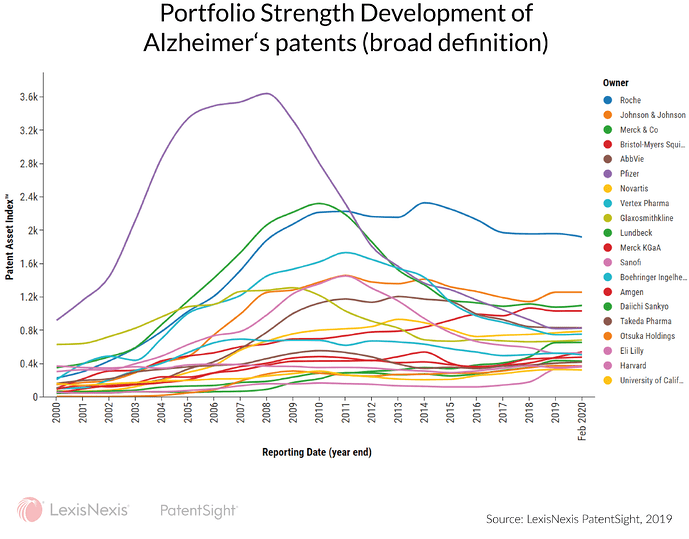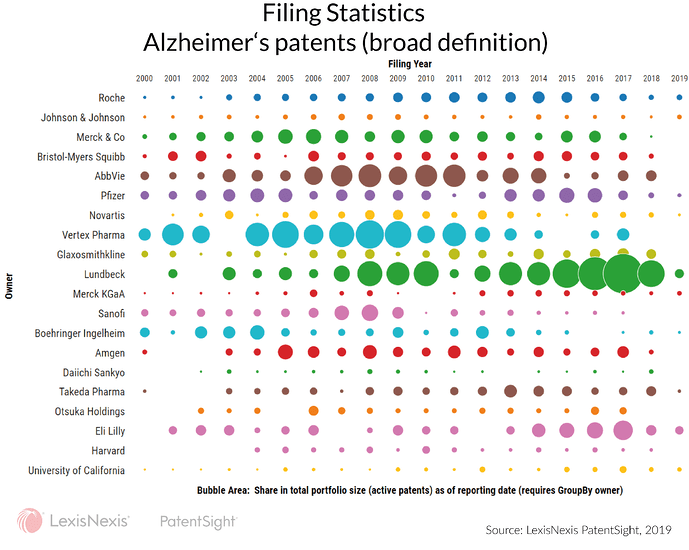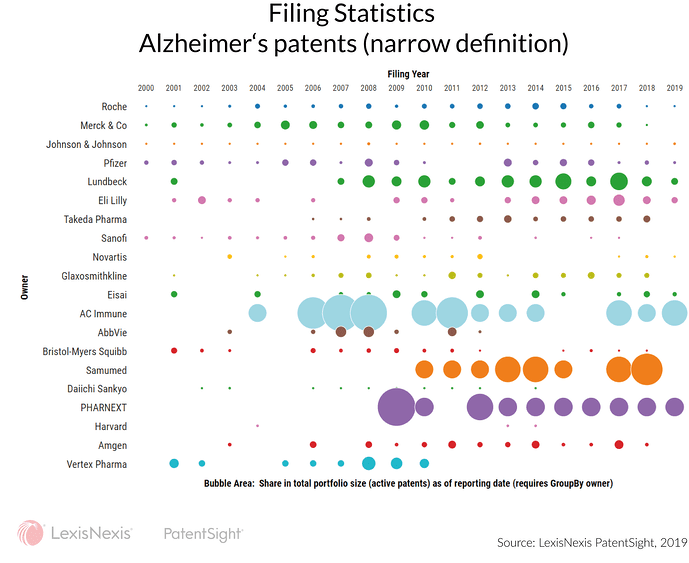Alzheimer’s Disease – Who is Still Fighting the Good Fight?

Sarbani Chattopadhyah
November 5, 2019
Finding a cure for Alzheimer’s disease has been a war that humankind and its various brains have been struggling to win for many decades now with little success. After having first identified the disease and its symptoms in 1906, we are not even close to a breakthrough. Most companies that had optimistically begun research, filed many patents and conducted clinical trials have either stopped or reduced investments in their researches into this field.
In order to take stock of the progress that’s been made in this fight, we decided to take a look at the patent landscape of drugs targeting Alzheimer’s disease. By considering both a broad and narrow definition of patents that deal with a cure for this disease we are able to clearly understand what has been done so far, where are we currently and where we are headed in the search for a cure.
Since the time Dr. Alzheimer could correlate the psychological and cognitive trouble faced by his patient to the abnormality in nerve cells, the treatment of Alzheimer’s disease (AD) has been one big uphill climb. Although developments in the scientific field of microscopy and diagnosis did shed more light in this direction, we are yet to find an absolute cure for the disease.
The search for a cure reached top priority levels when US president Ronald Reagan publicly acknowledged being diagnosed with AD. A few years ago AD was even declared as the sixth-leading cause of death in the USA. The fight against this disease has been arduous and the search for a cure, not quite fruitful. And it continues to be so till date.
What has been done so far?
Warner-Lambert’s (now part of Pfizer) drug named Cognex (tacrine) was the first to be FDA approved, for the treatment of AD symptoms, to hit the market. However, it had to be discontinued because of severe side effects including liver toxicity. Further research in the line of tacrine i.e. in the group of ‘cholinesterase inhibitors’, led to three new drugs in this group. The other approved drugs belong to the group of “NMDA receptor antagonists”. Most of the established pharma companies have invested their money, time and research faculty in looking for the all-elusive breakthrough for treating this disease. But so far, the drugs that are approved and finally reaches the market have only been successful in alleviating the symptoms of Alzheimer’s disease, but fall short of stopping or preventing further deterioration in cognition.
A patent landscape analysis of the field of Alzheimer’s disease reveals the direction and the approach taken on by pharma companies in this regard. Most of them seem to employ a broad definition for protecting their inventions (drugs) to cure AD. The general trend in patenting practice here being a strategy that discloses AD within the list of diseases that are related to the invention, for which patent protection is sought. If we look at the main players (Figure 1) who are focusing on this trend of targeting AD with a broad spectrum, the time evolution of the portfolio strength, as measured by the LexisNexis® PatentSight® Patent Asset Index, displays a downward trend for almost all the major pharmaceutical companies like Roche, J&J, Merck, Bristol-Meyers etc.

Figure 1
The drop in quality of patents isn’t much of a surprise as the news of Pfizer ending further research, into a drug for AD, has already been made public in early 2018 after they realised that they needed to ‘establish a better understanding of the development of the human brain’. At the time, this move even caused 300 job losses at Pfizer.
Bird’s eye view of the patent landscape
Such a look at the filing statistics, as shown in figure 2, of the top companies within a broadly defined research area, where AD can be any one of the many enlisted targeted diseases, already starts to give us an idea about the companies that have or are one the verge of giving up the righteous fight.

Figure 2
But, a Bird’s eye view provides little information about the actual scenario
However, such a broad look at the field doesn’t tell the entire story. Narrowing down the definition to include patents where the focus is concentrated on AD, shows a very different picture. The filing statistics analysis for such a narrowly defined field is shown in figure 3. Also notice how, between the Figures 2&3, the company ranking (as per the Patent Asset Index) has changed based on the narrow definition.

Figure 3
By analysing the proportion of patents that maintained a consistent principle focus on the treatment of AD within the total patent portfolio of each company, we can gain a much better understanding of actual development in AD specific drug developers. Such a narrow definition of patents in AD reveals the companies that have actually kept the fight alive against all odds. Pharmaceutical companies like Lundbeck, Eli Lily, AC Immune and PharNext have been consistently filing patents that fit this narrow definition for a long time now. Whereas some companies like Samumed and Takeda who joined this fight late, continue to file similar patents.
Different approaches to slaying the common dragon
Lundbeck who had already entered this market through Merz’s drug memantine under the brand name Ebiza faced failure in its own attempts for the drug ‘idalopirdine’ that was 5-HT6 antagonist in 2016 during clinical trials. However, the analysis of their recent filings indicate that they haven’t abandoned further development in this line of research altogether. Though Lundbeck’s main focus, at least in terms of protecting their inventions, is mainly in the direction of immunotherapy. On the other hand, Eli Lilly kept its research in developing Amyloid beta (Aβ or ‘Abeta’) inhibitors alive, probably with the expectation that their drug ‘solanezumab’ would pass clinical trials. The interesting observation is that Eli Lilly is also moving towards combination therapy and have already started inventing and protecting compounds associated with Dopamine that can be used in treatment of AD. On a completely different trajectory, Takeda pharmaceuticals has ventured into targeting the synaptic strength of neurons through AMPA receptors. They are also targeting ‘Monoacylglycerol lipase’ as therapeutic agent for AD. Pharnext who started working with combination therapies, continues to invent new combination therapies for treatment of AD, till date.
Based on our quality metrics Eli Lilly and Lundbeck seem to have developed portfolios that are similar in both size and quality. Does this also mean that they also approached this problem with similar strategies? We can understand this by looking either into individual patents or by looking at how their portfolios developed over time with respect to quality and quantity. Based on such an analysis, it can be clearly seen from the video below how these companies have differed in their strategic approach to developing high quality portfolios in this field.
Although none of these companies have been able to successfully develop a cure for the nefarious AD, we are optimistic that the existing Spartans will finish this war on the winning side and present humanity with a long awaited answer.
Learn more about PatentSight and the Patent Asset Index.
Watch the on-demand webinar Who is Taking the Lead in the Development of Drugs for Alzheimer’s Disease?
Excellent data quality is the foundation of reliable analyses. Learn how PatentSight enhances patent data here.
See how to produce highly informative patent landscape reports.
About the author: Dr. Sarbani Chattopadhyay
As a consultant, Sarbani assists clients in using PatentSight in the most optimal way, so that they get insights about patents, about their own portfolio, and portfolios of their competitors, and technologies they are working with, as well as which other technologies are being influenced by their inventions.
